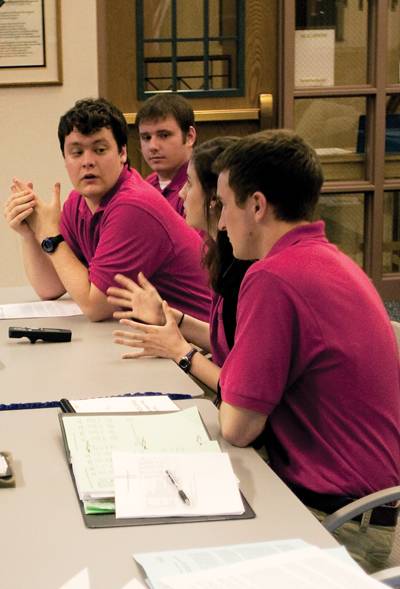Budget cuts hit Veishea

Tim Chwirka, senior in political science and Nick Dial, senior in History, Elyse Harper, senior in psychology and Mark Pierce, junior in agricultural business present their request for increasing the Veishea funds to the city council on Tuesday, Feb. 10th in the Ames City Council Chambers. The council decided to do further investigation before approving the request. Photo: Valerie Allen/Iowa State Daily
March 23, 2009
Even Veishea can’t escape economic woes.
Severe cuts from the president’s foundation account allocation and increased difficulty to find sponsorship have made finding money for Veishea more difficult than in the past.
The sponsorship committee is headed by Nick Dial, senior in history, and Allison Bryant, junior in industrial engineering. Dial said at the beginning of each year, the sponsorship committee sets a goal to raise at least $50,000. This year, Dial said the committee will be very lucky to raise 75 percent of the goal because of the economic crisis.
“We’re scrambling to make sure we get what we can from everywhere we can,” Dial said. “Everybody will need to be cinching up their belts.”
Dial said the largest source of on-campus sponsorship is the combined effort of the colleges.
The College of Agriculture and Life Sciences increased sponsorship in a very tight budget year to show its strong support for Veishea, said David Acker, associate dean of the college.
“The fact that students lead and implement the entire festival is what makes this attractive to our college because we believe that an undergraduate education must include opportunities to develop leadership skills,” Acker said.
While the Engineering and Agriculture & Life Science colleges are sharing sponsorship of Friday of Veishea and increasing funding to sponsorship, the College of Design will not be participating with sponsorship of Veishea. Mark Engelbrecht, dean of the College of Design, said the lack of involvement isn’t directly related to budget concerns, but rather a lack of student interest.
“There was no desire from the students to participate in Veishea,” Engelbrecht said, also mentioning that students have been occupied with other projects and don’t necessarily have the time to put together Veishea material.
Off-campus funding is dominated by the allocation from the city of Ames.
While the sponsorship committee asked for $10,000 from the city of Ames in February, Dial said insurance companies, seed companies and property managers also provide a part of the off-campus income.
Michael Weber, Veishea business manager and junior in family finance, housing and policy, said the major source of income for the nearly half-million dollar budget each year is the allocation from the president’s foundation account.
However, the allocation for Veishea 2009 of $200,000 is $50,000 less than last year’s allocation. The Veishea executive board has been informed that the allocation will be reduced another $50,000 next year to $150,000.
Next year, the Veishea budget will have experienced a $100,000 cut in income in just two years from the presidential account alone, roughly equivalent to 20 percent of the nearly $500,000 in estimated expenses.
When working under the tighter budget, Weber said eliminating excessive spending is vital in addition to increasing income from other sources.
While the sponsorship committee is tasked with bringing in as much income as possible to make up for the large cut, sponsors like Acker said support of Veishea is important “to send a very positive signal to ISU students, taxpayers and prospective students that we are alive and well and a great place to study and learn.”






